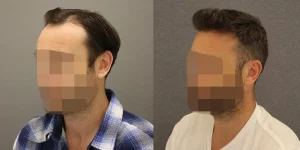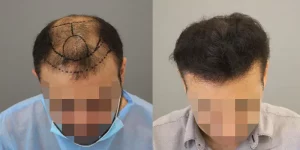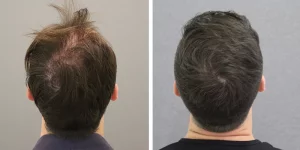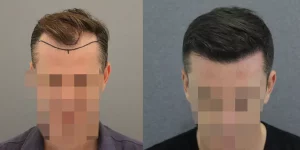FUE hair transplant is a highly sought-after technique due to its minimally invasive nature. Unlike the traditional strip method, FUE does not cause linear scarring at the donor area, resulting in a more natural and concealed appearance.
The FUE technique involves removing hair follicles directly from the donor site with a specialized tool and implanting them into balding or thinning areas. Visit the FUE hair transplant cost page to know how much this procedure will cost you.
Table of Contents
FUE Hair Transplant Goals
An FUE hair transplant in Dubai aims to provide:
- A fuller, thicker head of hair
- An enhanced youthful appearance
- Permanent hair growth in a natural manner
- A scar-free transplant with minimal downtime and recovery.
Benefits
FUE hair transplant in Dubai has some advantages over the traditional strip method transplant which include:
- Minimally invasive, without cutting or stitching the scalp.
- No visible linear scar at the donor site.
- Allows body hair extraction, suitable for those with limited donor hair on the scalp.
- Less discomfort and downtime due to its minimally invasive nature.
- Quick and smooth recovery.
Am I a suitable candidate for this procedure?
Ideal candidates for an FUE hair transplant in Dubai include those with:
- Permanent hair thinning, a receding hairline, or baldness.
- A desire for a minimally invasive procedure.
- Sufficient balding-resistant hair on their head.
- A tight scalp, unsuitable for the strip removal method.
- Stabilized hair loss.
FUE Techniques
Follicular Unit Extraction employs two techniques:
- Manual FUE.
- Auto FUE.
Manual FUE
In manual FUE, the surgeon uses a needle or punch to harvest hair follicles. The number of grafts per session varies based on individual cases and the surgeon’s assessment. Patients with advanced hair loss may need 2-3 sessions.
Manual FUE can be a time-consuming procedure, with sessions varying in length depending on the number of grafts required and the surgeon’s expertise. The duration of a session can range from a few hours to 8 hours or more, depending on the individual case.
Auto FUE
In robotic FUE, also known as Auto FUE, the surgeon uses a robotic device like the ARTAS system to assist in collecting follicular grafts. Auto FUE is quicker, more comfortable, and more productive than manual FUE, with a lower graft loss ratio. A study in the Journal of Dermatologic Surgery found the graft loss rate to be 8.3% for manual FUE and 4.9% for Auto FUE.
The graft loss ratio in Manual FUE vs. Auto FUE can vary depending on the surgeon’s skills and the technique used for the procedure. In general, Auto FUE (also known as robotic FUE) is associated with a lower rate of graft loss due to the precision of the robotic arm and the ability to carefully plan the extraction of each graft.
Pre-op Preparation
The outcome of your hair transplant depends on how well you prepare for the surgery. Here are some tips on how to prepare for the FUE hair transplant:
- Consult with your surgeon about medications to avoid before surgery, as this can vary based on individual health conditions.
- Purchase all prescribed medicines at least one week before the hair transplant.
Procedure
Step 1 – The donor area will be shaved to fully expose the hair follicles for easy extraction. For fewer than 1,500 grafts, a short crew cut will suffice.
Step 2 – The surgeon will draw the recipient area according to your desired hairline, ensuring the exact areas are covered by transplanted follicles.
Step 3 – Local anesthesia will be administered to numb the donor area, preventing pain or discomfort during extraction.
Step 4 – The surgeon starts the extraction process using a specially designed punch tool with a diameter of less than 1 mm to detach the hair from the scalp along with its roots.
Step 5 – The extracted follicles are trimmed under a stereomicroscope to remove any extra tissues or fat, obtaining grafts of the desired size.
Step 6 – Local anesthesia is administered to the recipient area, and the surgeon makes tiny incisions over the entire recipient area.
Step 7 – The surgeon carefully inserts each graft into the tiny incisions to complete the surgery.
Post-op Care
Follow these guidelines to achieve the desired results:
- Use cold compresses for post-surgical swelling and bruising.
- Start consuming prescribed medicines immediately after the transplant.
- Sleep in an upright position, with your head elevated at a 45-degree angle for the first few nights.
- Follow your surgeon’s instructions regarding when to wash your scalp after surgery.
- Avoid blood thinners or aspirin-containing medicines before and after the hair transplant, following your surgeon’s recommendations.
- Avoid exposing your scalp to direct sunlight for the first few weeks, as recommended by your surgeon.
- Do not scratch or pick at the scab.
- Avoid unnecessary touching of your scalp.
- Do not massage your scalp or apply pressure to the treated area for the duration recommended by your surgeon.
- Always follow your surgeon’s post-operative care instructions.
Recovery
Recovery after an FUE hair transplant is quick and smooth due to its minimally invasive nature.
- Your scalp will be sore and tender immediately after the transplant.
- A downtime of 36 to 48 hours is required.
- The initial recovery period is around 4 to 7 days, but complete recovery may take a couple of months.
- Most patients resume routine activities on the 3rd day after surgery.
- Complete recovery may take a couple of months.
Results
FUE hair transplant provides natural-looking, shiny hair. However, individual results may vary, and future hair loss can still occur in other areas due to factors like aging, genetics, and hormonal changes. FUE typically results in minimal scarring, making it less noticeable that you had a hair transplant. It is important to have realistic expectations of the treatment.




Common complications
Complications in hair implantation surgeries are rare but can include infections, bruising, swelling, redness, bleeding, and inflammation in the treated area. Follow post-op care instructions and consult your surgeon if you experience any unexpected side effects.
FAQs About FUE Hair Transplant
What is the difference between FUE Hair Transplant and FUT Transplant?
FUE and FUT are the two most frequently used hair transplantation techniques. FUT is an older, more invasive technique. In FUT, the surgeon excises a linear strip of hair-bearing skin from the donor area and dissects it to obtain grafts. In contrast, FUE involves no cutting or stitching of the scalp. It uses a small punch tool for direct extraction of individual grafts from the donor area.
Will FUE Hair Transplant leave a scar on my scalp?
FUE typically does not leave a linear scar but can result in small, dot-like scars at the donor site. These tiny pin-prick scars are not visible unless you shave your head.
Is FUE a painful process?
With local anesthesia, the patient does not feel pain during the procedure. However, some discomfort may occur post-surgery due to the healing process.
Is FUE more expensive than FUT?
Costs vary depending on the number of grafts needed, the clinic's location, and the chosen doctor. Generally, FUE is more expensive than FUT for similar cases.
Hair Transplant Surgeon
Free Consultation
Hair Transplant Surgeon Free Consultation If you are considering a hair transplant, the FUE procedure is highly efficient. Fill out the form below to book a free consultation with our experts. Dubai Cosmetic Surgery Clinic offers the best FUE hair transplant in Dubai with specialized staff and advanced techniques. Book your appointment now.
Fill in the form to get a consultation
100% Financing with 0% Interest

